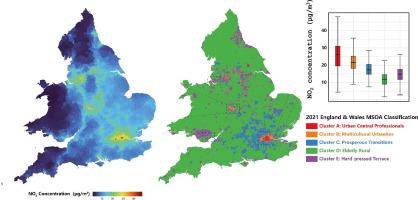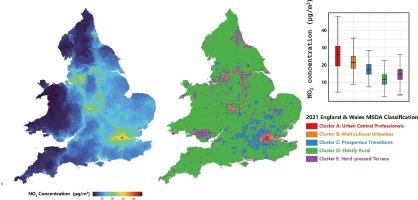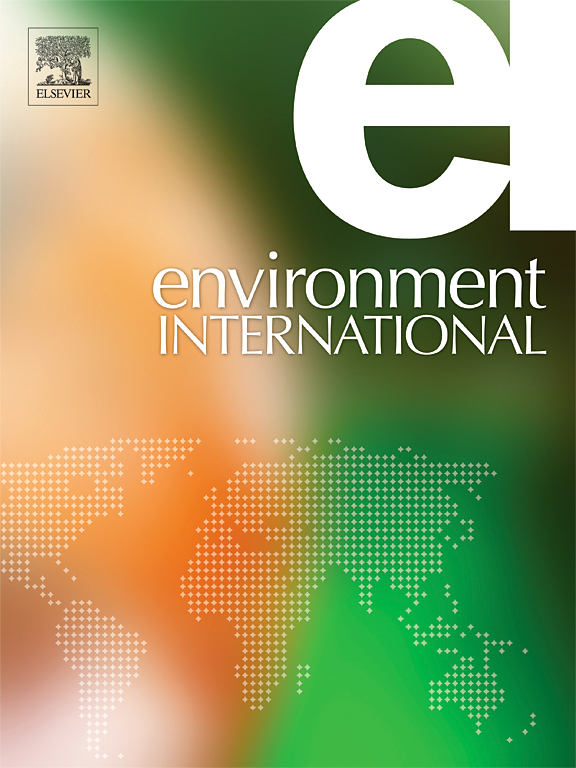Impact of net zero policy scenarios on air pollution inequalities in England and Wales
IF 10.3
1区 环境科学与生态学
Q1 ENVIRONMENTAL SCIENCES
引用次数: 0
Abstract
Background
The UK is committed to achieve net zero greenhouse gas emissions by 2050. The suite of policies needed to reach net zero will lead to improvements in air quality and, consequently, could lessen air pollution inequalities. We assessed air pollution inequalities across different sociodemographic groups in England and Wales and explored how these might be differentially impacted by future air pollution projections in 2030 and 2040 under net zero policies.
Methods
We employed a geodemographic classification approach to categorise neighbourhoods into five distinct clusters based on 2021 UK Census sociodemographic variables. We modelled fine particulate matter (PM2.5) and nitrogen dioxide (NO2) concentrations for the year 2019, and predicted concentrations in 2030 and 2040. We compared a business-as-usual (BAU) scenario and two policy pathways to achieve net zero currently considered by the UK government. We aggregated air pollution concentrations to the neighbourhood level and assessed differential neighbourhood-level concentrations across the geodemographic groups using descriptive statistics and box plots.
Results
The Urban Central Professionals group experienced 14 µg/m3 higher average NO2 concentrations compared with the Rural Elderly group in 2019. Despite substantial improvements to air quality in 2030 and 2040 of up to 6.3 µg/m3 for NO2 based on BAU, and further reductions of up to 2.4 µg/m3 NO2 under net zero policies, the overall pattern of inequality persists, but is predicted to be less pronounced.
Conclusions
Our findings demonstrate the effectiveness of targeted policies and innovations in reducing both air quality and greenhouse gas emissions and in bridging the environmental inequality gap. Our findings are essential to develop targeted communication campaigns to secure acceptance and willingness across the sociodemographic spectrum to support the significant behavioural changes needed to achieve net zero, by highlighting the wider co-benefits to the environment and health of such policies.


净零政策方案对英格兰和威尔士空气污染不平等的影响
背景英国承诺到 2050 年实现温室气体净零排放。实现净零排放所需的一系列政策将改善空气质量,从而减少空气污染不平等现象。我们评估了英格兰和威尔士不同社会人口群体之间的空气污染不平等现象,并探讨了在净零政策下,未来 2030 年和 2040 年的空气污染预测可能会如何对这些不平等现象产生不同影响。我们模拟了 2019 年的细颗粒物(PM2.5)和二氧化氮(NO2)浓度,并预测了 2030 年和 2040 年的浓度。我们比较了 "一切照旧"(BAU)方案和英国政府目前考虑的实现净零排放的两种政策途径。我们将空气污染浓度汇总到邻里水平,并使用描述性统计和箱形图评估了不同地理人口组的邻里水平浓度差异。结果2019 年,城市中心专业人员组的二氧化氮平均浓度比农村老年人组高 14 µg/m3。尽管根据 BAU,2030 年和 2040 年二氧化氮的空气质量大幅改善达 6.3 微克/立方米,根据净零政策,二氧化氮的空气质量进一步降低达 2.4 微克/立方米,但总体的不平等模式依然存在,但预计不会那么明显。结论我们的研究结果表明,有针对性的政策和创新在降低空气质量和温室气体排放以及缩小环境不平等差距方面都很有效。我们的研究结果对于开展有针对性的宣传活动非常重要,通过强调此类政策对环境和健康的更广泛的共同效益,确保社会人口各阶层接受并愿意支持实现净零排放所需的重大行为改变。
本文章由计算机程序翻译,如有差异,请以英文原文为准。
求助全文
约1分钟内获得全文
求助全文
来源期刊

Environment International
环境科学-环境科学
CiteScore
21.90
自引率
3.40%
发文量
734
审稿时长
2.8 months
期刊介绍:
Environmental Health publishes manuscripts focusing on critical aspects of environmental and occupational medicine, including studies in toxicology and epidemiology, to illuminate the human health implications of exposure to environmental hazards. The journal adopts an open-access model and practices open peer review.
It caters to scientists and practitioners across all environmental science domains, directly or indirectly impacting human health and well-being. With a commitment to enhancing the prevention of environmentally-related health risks, Environmental Health serves as a public health journal for the community and scientists engaged in matters of public health significance concerning the environment.
 求助内容:
求助内容: 应助结果提醒方式:
应助结果提醒方式:


